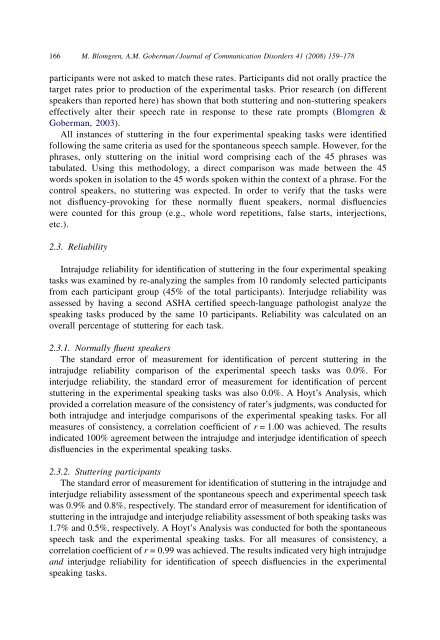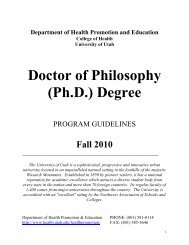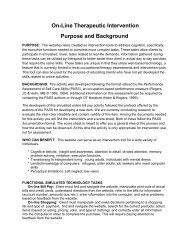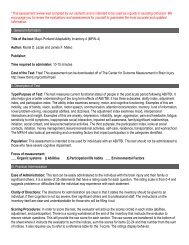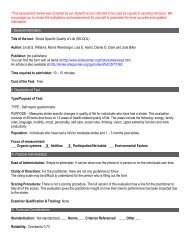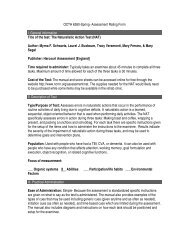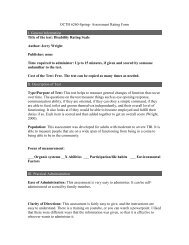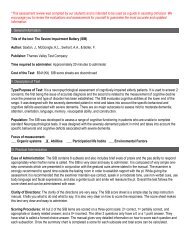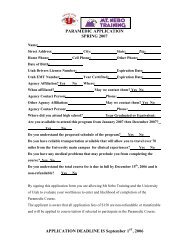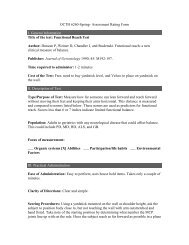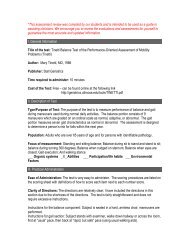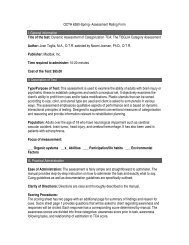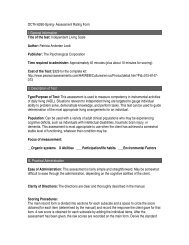Revisiting speech rate and utterance length ... - ResearchGate
Revisiting speech rate and utterance length ... - ResearchGate
Revisiting speech rate and utterance length ... - ResearchGate
Create successful ePaper yourself
Turn your PDF publications into a flip-book with our unique Google optimized e-Paper software.
166M. Blomgren, A.M. Goberman / Journal of Communication Disorders 41 (2008) 159–178participants were not asked to match these <strong>rate</strong>s. Participants did not orally practice thetarget <strong>rate</strong>s prior to production of the experimental tasks. Prior research (on differentspeakers than reported here) has shown that both stuttering <strong>and</strong> non-stuttering speakerseffectively alter their <strong>speech</strong> <strong>rate</strong> in response to these <strong>rate</strong> prompts (Blomgren &Goberman, 2003).All instances of stuttering in the four experimental speaking tasks were identifiedfollowing the same criteria as used for the spontaneous <strong>speech</strong> sample. However, for thephrases, only stuttering on the initial word comprising each of the 45 phrases wastabulated. Using this methodology, a direct comparison was made between the 45words spoken in isolation to the 45 words spoken within the context of a phrase. For thecontrol speakers, no stuttering was expected. In order to verify that the tasks werenot disfluency-provoking for these normally fluent speakers, normal disfluencieswere counted for this group (e.g., whole word repetitions, false starts, interjections,etc.).2.3. ReliabilityIntrajudge reliability for identification of stuttering in the four experimental speakingtasks was examined by re-analyzing the samples from 10 r<strong>and</strong>omly selected participantsfrom each participant group (45% of the total participants). Interjudge reliability wasassessed by having a second ASHA certified <strong>speech</strong>-language pathologist analyze thespeaking tasks produced by the same 10 participants. Reliability was calculated on anoverall percentage of stuttering for each task.2.3.1. Normally fluent speakersThe st<strong>and</strong>ard error of measurement for identification of percent stuttering in theintrajudge reliability comparison of the experimental <strong>speech</strong> tasks was 0.0%. Forinterjudge reliability, the st<strong>and</strong>ard error of measurement for identification of percentstuttering in the experimental speaking tasks was also 0.0%. A Hoyt’s Analysis, whichprovided a correlation measure of the consistency of <strong>rate</strong>r’s judgments, was conducted forboth intrajudge <strong>and</strong> interjudge comparisons of the experimental speaking tasks. For allmeasures of consistency, a correlation coefficient of r = 1.00 was achieved. The resultsindicated 100% agreement between the intrajudge <strong>and</strong> interjudge identification of <strong>speech</strong>disfluencies in the experimental speaking tasks.2.3.2. Stuttering participantsThe st<strong>and</strong>ard error of measurement for identification of stuttering in the intrajudge <strong>and</strong>interjudge reliability assessment of the spontaneous <strong>speech</strong> <strong>and</strong> experimental <strong>speech</strong> taskwas 0.9% <strong>and</strong> 0.8%, respectively. The st<strong>and</strong>ard error of measurement for identification ofstuttering in the intrajudge <strong>and</strong> interjudge reliability assessment of both speaking tasks was1.7% <strong>and</strong> 0.5%, respectively. A Hoyt’s Analysis was conducted for both the spontaneous<strong>speech</strong> task <strong>and</strong> the experimental speaking tasks. For all measures of consistency, acorrelation coefficient of r = 0.99 was achieved. The results indicated very high intrajudge<strong>and</strong> interjudge reliability for identification of <strong>speech</strong> disfluencies in the experimentalspeaking tasks.


